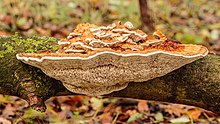| Fomitopsis quercina | |
|---|---|

| |
| The maze-like pores[1] of Fomitopsis quercina | |
| Scientific classification | |
| Domain: | Eukaryota |
| Kingdom: | Fungi |
| Division: | Basidiomycota |
| Class: | Agaricomycetes |
| Order: | Polyporales |
| Family: | Fomitopsidaceae |
| Genus: | Fomitopsis |
| Species: | F. quercina
|
| Binomial name | |
| Fomitopsis quercina | |
| Synonyms | |
| |
| Fomitopsis quercina | |
|---|---|
| Pores on hymenium | |
| No distinct cap | |
| Hymenium is decurrent | |
| Lacks a stipe | |
| Spore print is white | |
| Ecology is saprotrophic | |
| Edibility is inedible | |
Fomitopsis quercina is a species of mushroom in the order Polyporales. Commonly known as the thick-walled maze polypore,[2] maze-gill fungus oak-loving maze polypore, or oak mazegill, the specific epithet refers to the oak genus Quercus, upon which it frequently grows, causing a brown rot.[3] It is found in Europe, Asia, Northern Africa and Australasia. Though inedible, it can be used as a natural comb and has been the subject of chemical research.
Having previously been in the genus Daedalea, it was transferred to the new genus Fomitopsis in 2024, based on molecular phylogenetic data. The newly proposed name is Fomitopsis quercina (L.) Spirin & Miettinen (2024).[4]
- ^ Cite error: The named reference
Maze Poreswas invoked but never defined (see the help page). - ^ Arora, David (1986). Mushrooms demystified: a comprehensive guide to the fleshy fungi (Second ed.). Berkeley: Ten Speed Press. ISBN 978-0-89815-169-5.
- ^ Perley Spaulding (1961). Foreign Diseases of Forest Trees of the World: An Annotated List. U.S. Government Printing Office. p. 84.
- ^ Spirin, V.; Runnel, K.; Vlasák, J.; Viner, I.; Barrett, M.D.; Ryvarden, L.; Bernicchia, A.; Rivoire, B.; Ainsworth, A.M. (2024-03-15). "The genus Fomitopsis ( Polyporales , Basidiomycota ) reconsidered". Studies in Mycology. 107 (1): 149–249. doi:10.3114/sim.2024.107.03. ISSN 0166-0616. PMC 11003443. PMID 38600960.